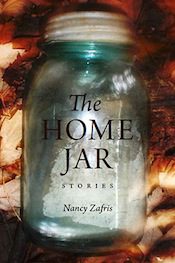
Anybody can forget anybody. So claims the vanished husband of Jarmilla Price, protagonist of “Digging the Hole,” the final story in Nancy Zafris’s challenging and powerful new collection The Home Jar. His assertion seems to have been the fatal gamble for many of Zafris’s characters. For Jarmilla, her husband’s conceit might as well be the principle guiding a career of bad choices: she’s spent decades “depositing” (as she sees it) unwanted, leprous children in a backwoods colony, a place where “they would be born again…but remain as nothing for the rest of their lives to the world outside.” This dark work prepares her to do something awful when, years later, her son brings home a former charge’s twin sister; Jarmilla’s retaliation against cosmic irony comes to seem like a dare the universe is only too happy to accept.
In “Swimming in the Dark,” painful memory lies in wait for a Japanese stewardess on brief holiday in Rome. Charmed by the decadently enacted bereavement of Americans who have come to dispose of a cremated loved one, the stewardess sneaks away from her crew to join in with what amounts to a bar-hopping mummer’s parade, and in doing so she pantomimes a private, personal tragedy of her own.
In “Prix Fixe,” a world-class chef hiding out from former renown in the sticks of southern Ohio gets the test he both desires and dreads when a condescending guest appears on a night whose diners otherwise “put the death in death row” (as he tells his sous chef). What this chef is unprepared for is how the challenge of artfully cooking up the local flora and fauna will return him to the sensation of letting go of his life’s big love. (On a side note—or as a side dish, if you like—the food writing here vividly captures both the erotic charge of impassioned cooking and the artistic mentality the chef has achieved by deferring an essential drive: “He grabbed the fire-hot rabbit loin from the oven and placed it over the eyeball tears of oil. The plate immediately burst with an exotic heat.”)
Rich as these and other tales of this nature are, they do not map the limit of Zafris’s interests and art. For here too see characters discover where their personal worlds end and a far larger, alien landscape begins (“Furgus Welcomes You” and “After Lunch,” the second enters a long tradition of Jewish shlemiel stories); watch wanderers reform and sometimes deform themselves to fit their circumstances. “White’s Lake”, a sophisticated tragi-comic story about an American, a Slovak, and a Czech trying to communicate in a dead Jew’s dacha in a Czech countryside where the ghosts of World War II and the Soviet Occupation threaten to transcend reality (let me refer readers to the impressive outhouse scene), performs the hat trick of amusing and saddening the reader before leaving her feeling hopeful for these characters. “The Home Jar,” about an Eritrean hotel employee supporting a wife and children back home, strikes out for the graver side of modern international experience. “My face grew old in a week’s passage under the weight of so many conflicting emotions,” he tells us, of leaving his family to travel to the U.S., “yet each time I handed over my passport or had my baggage sniffed by dogs and then fingered item by item before my eyes, or was asked to wait against a wall, I considered all the money and endless logistics and international agreements that enforced these precautions and it was as if the whole world was for a moment focused on me. This was a sensation I liked and only by pressing myself hard against the wall could I tamp down what threatened to become a smile.”

Zafris has built her reputation as a regionalist unafraid of leaving behind the safer subjects of atmosphere and local quirk and lighting out for the stranger territory of individual minds. Her novels The Metal Shredders and Lucky Strike treat settings as disparate as rustbelt Ohio and 1950s uranium-rush Utah, and her Flannery O’Connor Award-winning short story collection The People I Know was even more ambitious in its willingness to range far from home, exploring milieus as remote from each other as Tokyo and Miami. Yet where lesser writers would rest here on descriptions of place or cultural caricature in the hope of holding the reader’s interest, Zafris sets her sights on the higher ground of knowing characters on the terms they know themselves. What this requires is the courage to offer a theory of another person, a task steep enough that we often applaud when well-intended writers fail. Yet Zafris pursues her horizon until she finds it underfoot, sharing not only the habits of someone who hails from a different culture, but undergirding her portrayal with a sympathy that extends beyond anthropological curiosity into the realm of human respect. Consider this handling of a rural middle-aged couple from southern Ohio:
June Dieter moved in to help her husband. Her laborer’s hand swelled stop the spatula Dieter was holding. She guided his bigger, crustier hand, digging into it like prey, and forced out the energy and confidence. Together they stabbed at the eggs, then shoved them onto a plate. She flung her iron-colored ponytail over shoulder with what appeared to be flirtatiousness, for Dieter was watching her closely, his hand released to hang powerfully dead by his side, kicked over the door and delivered the breakfast plates herself. She left no doubt about whose hands had guided whose when they had first learned to love each other—and now, lesson given and lesson received, it was easy to picture them pawing each other in bed, something unbearably forceful and close to non- Christian in their tussling.
This is serious, imaginative, intellectual work, and its demands for attention and care are also promises of engagement, insight, and transformative emotional experience. There is plenty of darkness and weight in these stories, and yet they are watched over by a spirit of laughter and visited by a saving light, as in “A Modified Cylinder,” in which an apprentice wax figure artist sets about rendering the likeness of a girl whose parents have sustained her on life support for six years. This grim task, set the protagonist by an emotionally cold and artistically inferior master, calls to mind to nothing so much as Poe’s story “The Oval Portrait,” though crucial elements, including the quietly miraculous outcome, are perfectly reversed. Formally, the stories resemble tales and have an almost Twainian texture, and yet they are unmistakably contemporary in their concerns. The Home Jar makes for a deep and vivid read, one I recommend to lovers of serious fiction.




